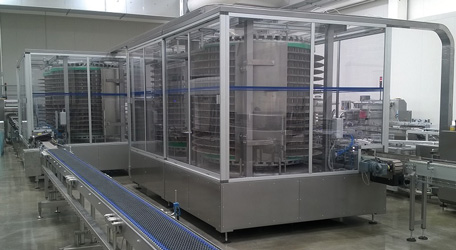 Al crescere delle cadenze produttive diventa fondamentale avere a disposizione buone capacità di accumulo per evitare di dover fermare la produzione e M.H. Material Handling risponde con i sistemi di accumulo BAT Buffer e Heliflex
Al crescere delle cadenze produttive diventa fondamentale avere a disposizione buone capacità di accumulo per evitare di dover fermare la produzione e M.H. Material Handling risponde con i sistemi di accumulo BAT Buffer e Heliflex
La ricerca della massima efficienza nelle linee di confezionamento richiede soluzioni che permettano di compensare le inevitabili micro fermate che si possono verificare nelle varie macchine della catena. Al crescere delle cadenze produttive diventa fondamentale avere a disposizione buone capacità di accumulo per evitare di dover fermare la produzione.
M.H. Material Handling risponde a queste esigenze con i sistemi di accumulo BAT Buffer e Heliflex.
Entrambi i prodotti sono buffer di tipo LIFO (Last In First Out):
• BAT Buffer utilizza la catena a tapparella BAT, realizzata da Rexnord su licenza di MH, avvolta a spirale e capace di raggiungere lunghezze fino a 150 m (ma si possono affiancare in serie 2 spirali ed aumentare tale capacità)
• Heliflex utilizza invece una speciale catena Rexnord avvolta su due tamburi, salendo su uno e scendendo sull’altro raggiungendo una capacità massima di 700 m.
In ambedue i casi la movimentazione della catena è regolata da inverter: nel caso dell’Heliflex o di doppia spirale BAT Buffer, l’inverter dei 2 motori sarà unico, in modo che siano perfettamente sincronizzati.
Per entrambi i buffer l’inserimento dei prodotti avviene tramite un sistema di devio a movimentazione pneumatica posto sulla linea principale che, al momento dello stop della macchina a valle, dirige i prodotti in arrivo verso il buffer.
Grazie all’azione dell’inverter, è possibile inserire i prodotti sul buffer mantenendo un certo passo in modo che non entrino in contatto tra loro e non si schiaccino, evitando possibili danneggiamenti.
Nel momento in cui la macchina a valle si rende nuovamente disponibile o nel caso in cui si fermi la produzione a monte, il buffer inverte il proprio senso di marcia ed entra in fase di scarico.
Il reinserimento in linea dei prodotti può avvenire in 2 modi, la cui scelta è legata al mantenimento o meno del senso di marcia rispetto al momento dell’inserimento.
• Nel caso in cui i prodotti debbano necessariamente mantenere il senso di marcia con cui sono entrati nel buffer, è previsto un sistema di restituzione dei prodotti tramite spintore pneumatico: la restituzione sarà limitata dalle prestazioni del sistema pneumatico.
• Nel caso in cui il senso di marcia dei prodotti risulti indifferente ai fini della produzione, la restituzione può avvenire tramite devio fisso su di un nastro di scarico e quindi tramite un sistema di unificazione con la linea principale: la restituzione sarà limitata unicamente dalla velocità di scarico del sistema.
http://www.mhmaterialhandling.com/it/prodotti/sistemi-di-accumulo/bat-buffer/
http://www.mhmaterialhandling.com/it/prodotti/sistemi-di-accumulo/heliflex/
LIFO buffer systems
With the growth of production rates becomes fundamental to have good capacity for accumulation to avoid having to stop the production, and M.H. Material Handling meets these needs with buffer systems BAT Buffer and Heliflex
The search for maximum efficiency in packaging lines requires solutions that allow compensating the inevitable micro stops that may occur on the various machines on the chain. With the growth of production rates becomes fundamental to have good capacity for accumulation to avoid having to stop the production.
M.H. Material Handling meets these needs with buffer systems BAT Buffer and Heliflex.
Both the products are LIFO (Last In First Out) buffers:
• BAT Buffer uses the BAT table-top chain, developed by Rexnord licensed by MH, wound in a spiral and capable of reaching lengths up to 150 m (but 2 spirals can be linked in series and increase this capacity)
• Heliflex instead uses a special Rexnord chain wound on two drums, rising on one and descending on the other reaching a maximum capacity of 700 m.
In both cases the chain movement is controlled by inverter: in the Heliflex case o for a double spiral BAT Buffer, the inverter will be unique for the 2 motors, so that they will be perfectly synchronized to the same frequency.
In both cases the loading of the products takes place via a pneumatic switch system placed on the main line that, when downstream machine stops, move incoming products out in buffer direction. Thanks to the action of the inverter, you can place the products on the buffer maintaining a certain pace so that they do not touch each other and do not crush, avoiding possible damage.
In the moment when the downstream machine becomes available again or if the upstream production stops, the buffer reverses its direction of travel and starts the unloading phase.
The in line reintegration of the products can be done in 2 ways, the choice of which is linked to the maintenance or otherwise of the direction of travel respect to the time of loading.
• In the case where the products must necessarily maintain the direction of travel with which they entered into the buffer, there is provided a product return system via pneumatic pusher: the return will be limited by the performance of the pneumatic system.
• In the case where the direction of travel of the goods is irrelevant for the purposes of production, the return may take place via fixed switch on an unloading conveyor and then through a merger system with the main line: the return will be limited only by the unloading speed of the system.
http://www.mhmaterialhandling.com/en/products/buffering-systems/bat-buffer/
http://www.mhmaterialhandling.com/en/products/buffering-systems/heliflex/









